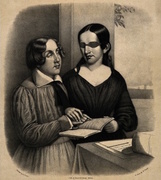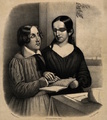
This huge ’60s sideshow banner—roughly 8 by 9.5 feet—was painted by esteemed circus artist Fred Johnson to promote the so-called Human Volcano. (Courtesy of Potter & Potter Auctions)
Walking home down Clinton Street in Manhattan’s Lower East Side one day in 1999, writer and filmmaker Laurie Gwen Shapiro encountered a tall, dark, and handsome man on the sidewalk swallowing fire. “Wow!”, Shapiro exclaimed, “Who are you?” It was beloved sword-swallower, magician, and collector Johnny Fox. After Shapiro and Fox chatted for a bit, he invited her into his museum. Shapiro looked at the brightly colored storefront behind him called the Freakatorium: El Museo Loco, and then back at Fox, who added, “Don’t worry, I’m not going to eat you!”

Johnny Fox performing a sword-swallowing routine at the Maryland Renaissance Fair in 2007. (Via WikiCommons)
Fox’s Freakatorium was a 21st-century cabinet of wonders, a narrow space chock-full of beguiling objects—some real, like a fossilized walrus penis bone, and some fake, like the Fiji mermaid, a creature made from the desiccated head of a man or a monkey sewn onto a fish tail, a “humbug” or “gaff” popularized by P.T. Barnum. The Freakatorium was a descendant of Barnum’s American Museum (and Scudder’s before that) in the 1800s and of the long-defunct 20th-century flea circus and freak show, Hubert’s Museum on 42nd Street, which Fox visited as a kid.
Inside the Freakatorium, the walls were filled circus sideshow posters promoting the likes of the Human Volcano, who appears to emanate flames from his mouth and hands, and pictures of bearded ladies and fully tattooed men; these historical images document another time, when sideshows were a standard form of entertainment. Live animals, including a two-headed turtle named Frik and Frak and a boa constrictor, welcomed visitors.
“There was a Willy Wonka feeling about it,” Shapiro says of the museum. She recalls being mesmerized by the skulls and shrunken heads. “It looked like a bizarro living room set up inside a storefront,” says the performer and sideshow historian known as The Lady Aye, who visited the Freakatorium on a few occasions.

Cabinet cards and trophies adorned Johnny Fox’s New York City museum, Freakatorium: El Museo Loco, which was open from 1999 to 2005. (Via Facebook)
Fox, who died last December at the age of 64, celebrated uniqueness. The name “Freakatorium” may raise eyebrows in a time that is much more enlightened about differences and disabilities, but unlike Barnum, who had a reputation for exploiting marginalized people for profit—despite his heroic portrayal in last year’s biopic, “The Greatest Showman”—Fox is remembered as a lovable, vivacious guy whose philosophy was “Let your freak flag fly.” In a television interview from the early aughts, he told viewers, “I remember going to see a sideshow, and I thought, ‘Wow, these are the real superheroes,’ because of their bravery in standing in front of people, and saying, ‘Hey, yeah, this is me.'”
“There was a Willy Wonka feeling about it.”
“He was so engaging—incredibly curious, insatiable, and generous. He knew things that other people didn’t know,” Shapiro says. When she was working on a documentary called “Keep the River on Your Right: A Modern Cannibal Tale” and couldn’t locate a photo of the Wild Men of Borneo, two exceptionally strong, mentally disabled little people who performed for Barnum, she asked Fox if he had ever seen a picture of them. “Within five minutes,” she says, he had one in his hands that she could use in the film.
That photo, amidst hundreds of other items from Fox’s collection, is headed to auction in Chicago on November 10. Potter & Potter Auctions, well-known for its magic-themed sales, will host the auction. The company’s co-founder, Gabe Fajuri, knew Fox from the magic community. He describes Fox as part of “the grand tradition of all these fairground entertainers who could make you laugh, could make you gasp in awe,” adding, “Johnny was a wild man. There’s no question about it, but he was an exceptionally well-educated wild man.”

A mid-20th-century Tantric Himalayan Buddhist ritual Kapala skull, or a human skull decorated with semi-precious stones, glass eyes, and Tibetan silver work. (Courtesy of Potter & Potter Auctions)
First and foremost, Fox was a performer. He ate fire, until he learned that the chemicals were bad for his liver, he pounded spikes into his nose, and he swallowed swords—a record-breaking 16 swords at once. Susie Fox, his second wife and the mother of his son, Kelly Fox, remembers Johnny as a consummate entertainer. She recalled a trip to a sword-making factory in Spain once when Johnny pulled a sword off the wall and swallowed it, to the delight of all the workers. He was an accomplished sleight-of-hand artist and illusionist, and this is reflected in the auction offerings, among them his “Cracker Shooting” helmet, a repurposed WWI helmet Fox used for his version of a stunt that involved swallowing a loaded gun barrel and then shooting a cracker off the head of a volunteer from the audience.
Fox executed these feats all over the world, from New Zealand to Coney Island, but his home base was the Maryland Renaissance Festival, where he regaled audiences for 37 seasons, even in the summer before his death from liver cancer. A stage there was renamed in his honor.
“He was pretty amazing,” says Susie, who met Johnny at the Colorado Renaissance Festival about 40 years ago. During the early years of their marriage, she watched him become a collector, she said. “He loved buying unusual things—and would never sell anything.”
His collection runs the gamut from oversized banners and broadsides to photographs and cabinet cards, and, of course, tons of curiosities. Fajuri says it’s tough to choose a favorite, but he is partial to the sideshow banners, of which there are a few in the sale. One giant banner (27’ long by 9’ tall) proclaims “Freaks. Past and Present.” Made by Fred Johnson, a well-known painter of circus signage, circa 1950, it depicts acts from the heyday of the sideshow: the three-legged man, frog boy, the sword-swallower, etc. Estimated at $4,000-6,000, it is one of the priciest lots in the sale. There are also several mid-century banners by Snap Wyatt, another renowned banner painter, including one reading “Freaks. Alive” and another that advertised “Lobster Boy.”

A “boudoir card” of the Sacred Hairy Family of Burma, two of whom had hypertrichosis and were exhibited by P.T. Barnum in England for one season, and for a short tour in the United States, in 1888. (Courtesy of Potter & Potter Auctions)
Some of these so-called “freak show” spectacles were indeed phony, while others centered on people with congenital disorders—some who had the freedom to chose the stage life, and others who were basically enslaved from childhood. For those who elected to get into show business, sideshows provided them work opportunities at a time prior to the disability-rights movement, when they faced otherwise insurmountable job discrimination, but they had to subject themselves to public humiliation. Because of the progress disability advocates have made, gawking at a person’s “otherness” for kicks is now considered reprehensible.
Fajuri said the auctioneers were surprised to discover three Diane Arbus photographs in Fox’s collection. Two circa-1970 silver prints of Lady Sandra Reed, aka the Albino Sword Swallower, are believed to be unique “test prints” made by Arbus. The prints are accompanied by a 1991 note from Reed to Fox. Another Arbus photo from the same time period, this one of William Durks, a man with a severely deformed face, standing in front of a circus tent, also entered Fox’s collection via Reed, who inscribed it to “my best friend Fox.” There are also cabinet-card photos of snake charmers and little people by the famous Bowery photographer, Charles Eisenmann, and an 1880s “boudoir card” portrait of the Sacred Hairy Family of Burma, who suffered from hypertrichosis and did a short stint with Barnum in 1888 before mysteriously disappearing.
Barnum-related photography, books, and ephemera pop up throughout the collection, including the carvings and correspondence of the “Armless Wonder” Charles B. Tripp (1885-1930), who toured with Barnum’s sideshows showing off his skills as a carpenter and a calligrapher—he used his feet. But the famed ringmaster is perhaps best conjured by the Tom Thumb artifacts. Charles Sherwood Stratton, alias General Tom Thumb, was a man of short stature who was “discovered” by Barnum when he was 4 years old and became an international star for the rest of his life. Fox owned a number of Thumb’s things, including a leather boot and a vest worn by the performer, a pair of his gloves, an ornate walking stick, and a trunk full of stuff that Thumb shared with his wife, Lavinia.

A diminutive overnight trunk owned by Tom Thumb and his wife, Lavinia, circa 1870, as exhibited at the Freakatorium Museum. Items within the trunk include two of Lavinia’s unmatched gloves as well as one high black shoe, a Tom Thumb-owned leather glove, his top hat, a partial deck of miniature playing cards, Lavinia’s copy of the play “All Tangled Up,” and a hand-colored CDV of Tom and Lavinia Thumb and their child. (Courtesy of Potter & Potter Auctions)
Collectors of so-called oddities will have the most fun pawing through the catalog of Fox’s collection. Take, for example, “Fluffy,” the mummified cat, which, according to the auction catalog, “traveled in sideshows for many years after being discovered during the demolition of an old building in New York.” Or, a vintage shrunken head: The one displayed at the Freakatorium as the genuine article was more likely an early 20th-century facsimile made in South America of various leathers and human hair. Perhaps you prefer a wax head instead? Fox owned the disembodied wax heads of Mao Zedong, Julius Caesar, Stephen F. Austin, and Sir Walter Raleigh, all made in the ’60s by the Gems of London, which specialized in such figures for exhibition. Another highlight is a bezoar stone removed from the intestinal tract of Wexy, a royal war horse that died at Waterloo in 1815; bezoars were thought to be useful antidotes to poison. And then there’s a Victorian-era embalming table, an antique chastity belt, a dish of glass eyes, and so much more.
“I remember going to see a sideshow, and I thought, ‘Wow, these are the real superheroes.’”
Fajuri believes the breadth of the collection will appeal to everyone, from educational institutions to “weirdos.” “There’s some interesting material here that is suitable for a library, and then there’s, you know, conjoined fetal pigs in a jar,” he says. “That’s just something somebody wants to post on Facebook and say, ‘Look what I got!’”
In 2005, the Freakatorium became a victim of Lower East Side gentrification. Fox’s rent more than doubled, and he was forced to close the museum. His $5 admission fee and the light foot traffic weren’t cutting it. At the time, Fox told the New York Times, that he hoped to keep the Freakatorium collection intact—the desire of most collectors—but he couldn’t secure a space or a benefactor. “So after that, Johnny moved everything up to his house in Connecticut. He didn’t really have a venue to exhibit all the stuff, so a lot of it was sitting in a huge barn on his property,” Fajuri says. The collection remained there until it was packed up for auction earlier this year; according to Fajuri, he and Fox had discussed the sale of the collection just a week before his death.
Although the collection will be scattered when it goes under the hammer next month, it still feels like Fox’s wish for it, as conveyed to author Marc Hartzman soon after the Freakatorium opened, will be fulfilled, albeit on a more individual basis: “I want it to continue to bring happiness, wonder, awe, or disgust to people. Whatever it stirs up.”

Johnny Fox’s “Cracker Shooting” Helmet. The volunteer may have donned this helmet, which allowed Fox to place a cracker in the slot on top. Then Fox would swallow a loaded gun and proceed to shoot the cracker off the volunteer’s head. The repurposed WWI helmet was used by Fox for his version of the stunt made famous by Kar-Mi (Joseph Hallworth). (Courtesy of Potter & Potter Auctions)
(Rebecca Rego Barry is the author of Rare Books Uncovered: True Stories of Fantastic Finds in Unlikely Places and the editor of Fine Books & Collections magazine. She writes about books and history for JSTOR Daily, Slate, Lit Hub, and elsewhere.)

 Dark Art: Spectacular Illusions from the Golden Age of Magic
Dark Art: Spectacular Illusions from the Golden Age of Magic
 Healing Spas and Ugly Clubs: How Victorians Taught Us to Treat People With Disabilities
Healing Spas and Ugly Clubs: How Victorians Taught Us to Treat People With Disabilities Dark Art: Spectacular Illusions from the Golden Age of Magic
Dark Art: Spectacular Illusions from the Golden Age of Magic Mummies and Monkey Skulls: 'Oddities' Host Ryan Matthew Cohn on Creepy Antiques
Mummies and Monkey Skulls: 'Oddities' Host Ryan Matthew Cohn on Creepy Antiques Magic Posters and EphemeraThe Golden Age of Magic (1875-1930) generated thousands of colorful posters…
Magic Posters and EphemeraThe Golden Age of Magic (1875-1930) generated thousands of colorful posters… TaxidermyTaxidermy evolved out of the tanning trade, whose practitioners preserved t…
TaxidermyTaxidermy evolved out of the tanning trade, whose practitioners preserved t… Circus MemorabiliaWhat we think of as a "circus"—a spectacle including human daring, acrobati…
Circus MemorabiliaWhat we think of as a "circus"—a spectacle including human daring, acrobati… Mari Tepper: Laying it on the Line
Mari Tepper: Laying it on the Line Nice Ice: Valerie Hammond on the Genteel Charm of Vintage Canadian Costume Jewelry
Nice Ice: Valerie Hammond on the Genteel Charm of Vintage Canadian Costume Jewelry How Jim Heimann Got Crazy for California Architecture
How Jim Heimann Got Crazy for California Architecture Modernist Man: Jock Peters May Be the Most Influential Architect You've Never Heard Of
Modernist Man: Jock Peters May Be the Most Influential Architect You've Never Heard Of Meet Cute: Were Kokeshi Dolls the Models for Hello Kitty, Pokemon, and Be@rbrick?
Meet Cute: Were Kokeshi Dolls the Models for Hello Kitty, Pokemon, and Be@rbrick? When the King of Comedy Posters Set His Surreal Sights on the World of Rock 'n' Roll
When the King of Comedy Posters Set His Surreal Sights on the World of Rock 'n' Roll How One Artist Makes New Art From Old Coloring Books and Found Photos
How One Artist Makes New Art From Old Coloring Books and Found Photos Say Cheese! How Bad Photography Has Changed Our Definition of Good Pictures
Say Cheese! How Bad Photography Has Changed Our Definition of Good Pictures Middle Earthenware: One Family's Quest to Reclaim Its Place in British Pottery History
Middle Earthenware: One Family's Quest to Reclaim Its Place in British Pottery History Fancy Fowl: How an Evil Sea Captain and a Beloved Queen Made the World Crave KFC
Fancy Fowl: How an Evil Sea Captain and a Beloved Queen Made the World Crave KFC
Leave a Comment or Ask a Question
If you want to identify an item, try posting it in our Show & Tell gallery.